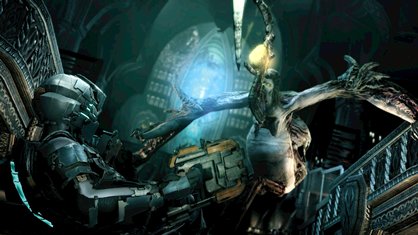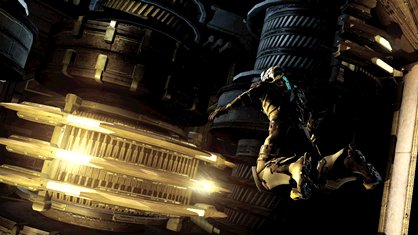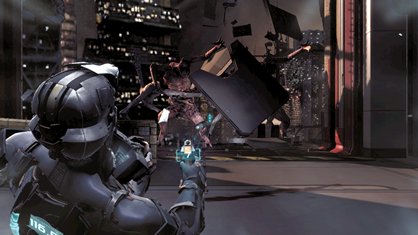These set-pieces are being dubbed “epic moments” by Visceral, and every chapter of the story will be punctuated by at least one. If you’re not getting sucked out of a window and chopped in half, you’ll be fighting huge bosses from the inside (see also: Lost Planet 2), and standing on top of a high-speed train, fending off waves of necrotised human flesh. On one hand, it’s a compromise in terms of pure, oppressive terror. On the other, it gives you a chance to add the occasional “whoo-hoo” to your well-rehearsed repertoire of “uh-oh” and “shitshitshit.”

One of the design elements that made Dead Space such an immersive experience was the genuine lack of a HUD. It’s something of a developer cliche to claim that you’re “minimising the HUD,” but Dead Space did it with genuine style, working every last bit of information into the objects and technology of the game. Video logs, communication with your surviving team members, and operating your inventory was all done through in-world holograms. The action doesn’t pause for you to sort out your ammo, and nowhere was designated a safe place. That’s all still in place – all the important information is still tucked discreetly away.
The anti-gravity moments from the first game have changed too. In the first game, you barnacled yourself to a wall, and pushed in a direction, using your unguided flight path to spin around and shoot necromorphs who were travelling in similar straight lines. Since then Isaac has picked up a jet pack with a set of jet boots. It’s not going to turn the game into a Dark Void Rocketman affair, but it does give you enough power to guide yourself through zero-G bits.

This means Isaac’s travels around the Sprawl are a more open affair than the optionless tram system that ruled your progress through the slightly-too-similar areas of the Ishimura. That’s the greatest source of improvement in Dead Space 2’s new setting: variety. A just-begun thriving city offers locations far more interesting than a bridge, shuttle bay, and crew quarters. And its location – the Rings of Saturn, for Christ sakes! – makes for an infinitely wider array of settings.
Spacewalking across walkways is pretty much to be expected, but fixing up a solar array on the surface of a planet that’s been cracked open with lasers, and mined for resources? That sounds like whole new league. The defining mood of the first game was isolation – haunting space loneliness. You had contact with the two surviving crewmates from the Kellion, but mainly it was video logs from the dead, and a positively frosty welcome from their corpses. The sequel has Isaac being more human by dealing with people – we’re early enough in the viral cycle to have pockets of desperate survivors on the Sprawl.
Guiding squads of survivors around would be a radical change of tone, and Visceral Games are cautious about suggesting this is a new direction. Dead Space 2, they say, will primarily be about Issac Clarke fighting the alien living dead by himself. But dealing with real people might give the game an extra dimension, and it certainly gives Clarke a reason to take his helmet off more often. The constant looming threat of the first game is now tempered with regular moments of what street urchins might call “kickassery” – tension-breaking moments in which you’re empowered with the ability to blow all shades of shit right up.

What Visceral are doing with Dead Space 2 appears to be taking it in a more cinematic direction, with new ways for the necromorphs to pervert the human form and unsettle the player, and more balancing moments to throw the points of tension into relief. We’re looking forward to seeing how a world with more survivors and locations works out. It’s got the potential to ruin the mood of the franchise, for sure, but it could also blow the game open into exciting new territories.
Weekly digests, tales from the communities you love, and more
Feb 23, 2010


